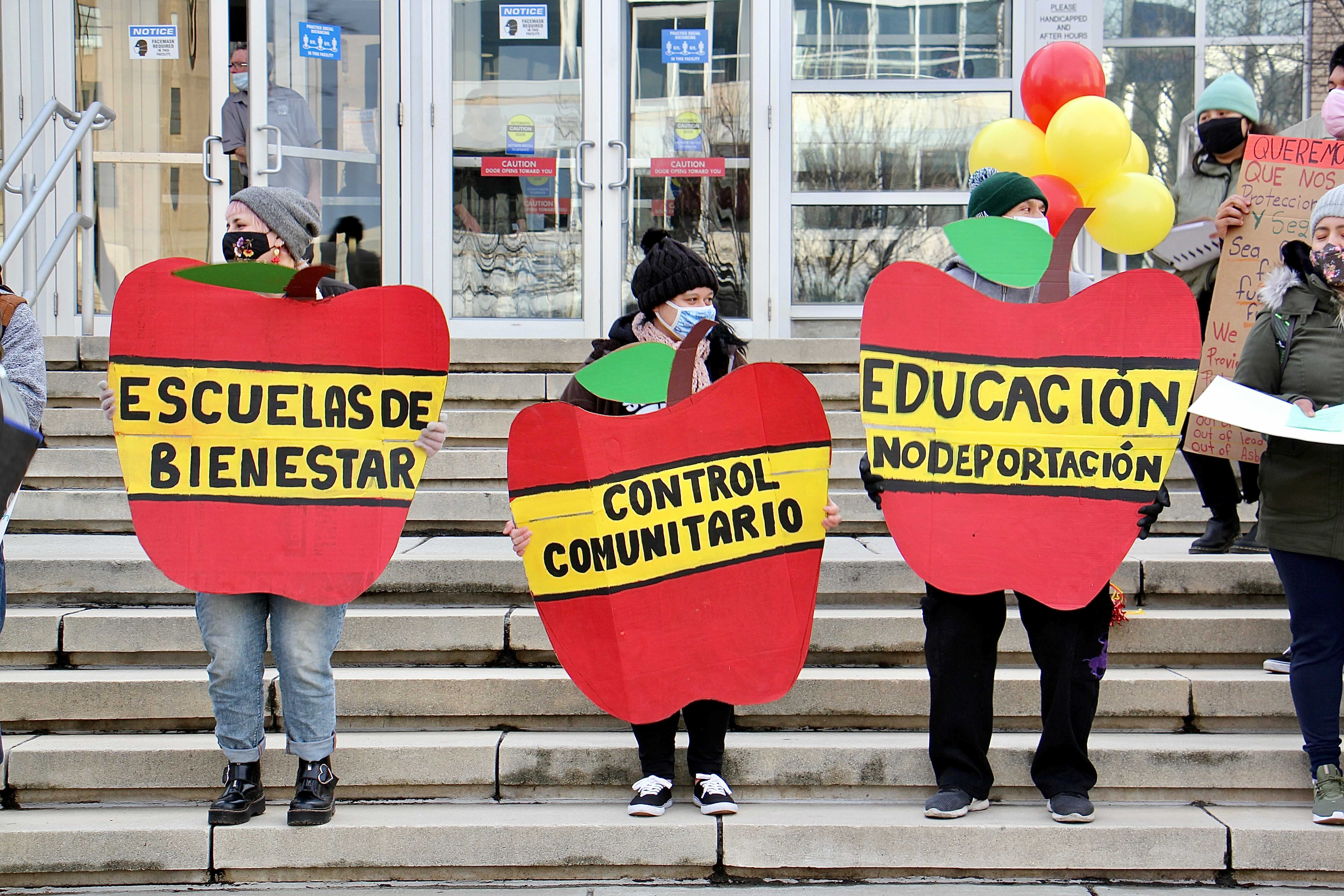Immigrant activists want Philly teachers trained on dealing with ICE
An immigrant rights group says Philly teachers and staff don’t know what to do should immigration enforcement ask for information on students. They’re trying to change that.

Members of Juntos rally in front of the Philadelphia schools administration building calling for the district to support immigrant students and their families. (Emma Lee/WHYY)
If immigration enforcement were to come to public schools in Philadelphia regarding a student and their family, would teachers or staff know how to respond?
Immigration advocacy group Juntos and a coalition of supporters, including educators and City Councilmembers Kendra Brooks and Helen Gym, say the answer is no, and they want to change that.
“The district needs to make sure that everyone knows what to do if [U.S Immigration and Customs Enforcement] comes to my school, your school, or your school someday,” said Rodrigo Fernandez, a bilingual counseling assistant at the Southwark School in South Philadelphia.
On Monday, Fernandez was part of a crowd of about 50 people gathered in front of Philadelphia School District headquarters to launch the Sanctuary School Campaign.
The campaign focuses on five principles: schools free of criminalization, reinvestment in education, culturally responsive pedagogy, community control of schools, and restorative learning environments.
The language of the demands echo those made over the summer when activists called for police-free schools and criticized that the district can’t keep workers and students safe from the coronavirus or other health hazards.
The demand that the district does a better job at training teachers how to deal with ICE agents comes one year after agents arrested a woman waiting for the bus after she’d dropped her child off at Eliza B. Kirkbride Elementary in South Philly.
Veronica Carmen Lara-Marquez, who was three months pregnant at the time, was later released for “humanitarian reasons.” But the arrest shook immigrant advocates, as it ignored an ICE policy that regards locations such as schools, churches, and hospitals as “sensitive locations,” and discourages enforcement at these sites.
At the time, Philadelphia Superintendent William Hite said the district was educating staff on what they were and weren’t required to share with immigration enforcement.
The incident, in what’s supposed to be a so-called sanctuary city, sparked an interest in Juntos to evaluate just how much teachers and staff know about immigrant families’ rights in these types of scenarios.

Between December 2020 and January of this year, Juntos surveyed 350 of the school district’s 19,000 staff members and found 73% of respondents did not know who to notify should ICE press them for information about a student or the student’s family.
Though the sample is small, the respondents were reached through grassroots networks and the teachers union, said Juntos leaders, which suggests some of the most engaged employees in the district don’t know how to react should ICE visit their school.
The district does keep an almost-60-page “Immigrant and Refugee Toolkit,” which addresses questions such as what to do if a child’s parents are deported: exhaust the child’s emergency contacts and stay with them until they arrive. Should ICE officers demand access to a school, the toolkit says even with a warrant, the school in question needs to notify the superintendent and/or the Office of General Counsel.
This December, the district released a series of “goals and guardrails” seen as key to boosting student achievement and making sure students graduate high school with the tools to “succeed in the global economy.”
The goals and guardrails were also designed to address systemic racism. Pep Marie, with Our City Our Schools, said the district is currently undermining its own goals.
“ICE is a racist and violent institution and a lack of clarity around the school district’s engagement with ICE contradicts a welcoming and enriching school experience for students and their families that they seek to partner with,” Marie said.
For immigrant parents like Aracely Isidoro, however, there are other failures the district needs to address with similar urgency.
Isidoro, who has four children in the district, said her daughter has been acting as a translator since the age of 12 because her South Philly school has no one else who can translate teacher messages to parents.
In one instance, Isidoro’s child was pulled from class to tell a first grader’s parents that their child had fallen.
“I’ve always taught my daughter to help if someone needs it, but every time they pulled her from calls they were violating her right to education, be a girl, and fully participate in her classes,” Isidoro said.
Erika Guadalupe Núñez, executive director of Juntos, called on the district to adopt a resolution that includes a mandated emergency response “in order to help ensure the safety and emotional well-being of our students who may be impacted by enforcement actions.” It also calls for teacher training on how to deal with ICE and for the district to stop buying any additional metal detectors or facial recognition software.
“Our campaign is a community response critically outlining the need for a truer commitment from the district of Philadelphia to ensure our youth and parents are safe from criminalization, from failing infrastructure, from language barriers, and those that seek to make decisions that impact the well-being of our people without a direct conversation,” Núñez said.

Get daily updates from WHYY News!
WHYY is your source for fact-based, in-depth journalism and information. As a nonprofit organization, we rely on financial support from readers like you. Please give today.







